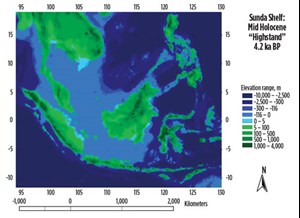What's new in exploration
Many explorationists are asked to look at a specific x, y situation, tasked with “if there are hydrocarbons on a lease, where are they?” I wish more land men and management would ask the explorationist that question first. Some do, and the folks they ask are a small, elite breed of humans. Rarely are they right.
Safety of the herd. Excuse this analogy/metaphor, but explorationists are sometimes like medical practitioners. Some give pills, some cut and sew; others stare for years into a microscope. Generally, the “microscopers” find something new, based on past results taken from corpse samples, the “cutters” perform after practice on lots of cadavers, and the “pill givers” work the status quo for the deteriorating living, after years of tests on those pills. We normally do not have liability lawyers chasing us for failures, but we still pay an extreme price.
I would agree that George Mitchell and his small staff get the credit, or blame, for the break-out in micro-fracing that resulted during the shale oil boom, big B-to-A. The truth is that fracing technology has been in widespread use for over 50 years, while some evidence suggests way over 80. The better question is, why did we not see the shale oil boom sooner? One reason is that we used what we call the normal, approved E&P methods that would not get us fired. We follow or flee with others from A to B and keep to the safety of the herd.
Fortunately, there have been other explorers thinking B-to-A. Examples include Heron of Alexandria, Euclid, Leif Erikson, Marco Polo, Leonardo da Vinci, Chris Columbus, Rafael Bombelli, Isaac Newton, Euler and Gauss, George Washington, Lewis and Clark, Mary Anning, William “S” Smith, Caroline Herschel, Jules Verne, Wm. Rowan Hamilton, John Wesley Powell, Octavie Coudreau, David Livingstone, Marie Curie, Albert Einstein, J. Clarence Karcher, Lucien LaCoste/Arnold Romberg, Rosalind Franklin, Yuri Gagarin, Alan Shepard, John Glenn, Dorothy Hodgkin, Neil Armstrong/Buzz Aldrin/Michael Collins, Bill Gates/Paul Allen, Steve Jobs/Steve Wozniak/Ronald Wayne, Barb McClintock, Peter Vail, George Mitchell, Leon Thomsen, and many others!
New ideas. I remember a story at Marathon Oil, where a North Sea purchase was acquired, based on other firms' nearby discoveries, enticing the company into the deal. MOC dry holes, 1, 2, 3, 4, 5 and 6, followed. Harold Hoopman, president of Marathon, came into a depressed A-to-B strategy session and said, “There is oil in that lease, drill another.” Discouraged senior members of the team turned to a young geo, who pointed to a map he made with “yellow” erasable pencil. That was well 7, and the Brae “area” is history. The geo, a 20-something named Larry Miller, is now retired. Bull-headedness is sometimes rewarded. New ideas, B-to-A—if heard early and evaluated—can save a lot of pain and dollars.

Technology is broadcast as our savior [or destroyer]. Tech, alone, will produce little without the human skill to implement and optimize. SEG/SEAM models are a break-out exploration technology, created and mentored by the best experts we have. SEAM models are the high tech for several geophysical methods constructed around the upper limits of each respective theory. Yes, 90% of explaining geo-anything [rocks or digits] is still a “theory.” While these models are instructive, real power is occurring among the members that are using the models to perfect in-house tool sets, and to innovate new methods. They are learning methodology limitations, thereby redefining their overall exploration risk. This entire technology is available for less than what we used to pay for a workstation. Other than market factors, cash flow and lack of imagination [i.e., A-to-B], I do not understand why everyone in our business is not a part of this grand experiment.
Nature working B-to-A. Sea level changes from all causes have been documented in paleo maps prepared for oil exploration. A few that I have seen interpret hundreds of meters of vertical change in the GOM, several times over the last few million years. Ice comes and goes, seal level rises and falls, and so do landforms. Modern man [clothes, cigars, beer and bows] saw a few.
Here is an example of a 5-m high-stand over the Sunda area, Southeast Asia, a great place to explore for oil and gas. The Field Museum of Chicago felt comfortable showing ancient global warming data, pre-modern petroleum and pre-Ameri-Euro industrial-man, for an affected area outside of Chicago’s political base. Since China, India, Greece and Egypt were industrial at the time, did they cause this? What happened to sea level after that? Nature working B-to-A. ![]()

- Applying ultra-deep LWD resistivity technology successfully in a SAGD operation (May 2019)
- Adoption of wireless intelligent completions advances (May 2019)
- Majors double down as takeaway crunch eases (April 2019)
- What’s new in well logging and formation evaluation (April 2019)
- Qualification of a 20,000-psi subsea BOP: A collaborative approach (February 2019)
- ConocoPhillips’ Greg Leveille sees rapid trajectory of technical advancement continuing (February 2019)


